BeeHive208S
- 103303 supported devices from 344 manufacturers by 3.33 version of SW (29. Jun. 2017)
- eight independent universal programming modules (BeeProg2 based) in one unit
- extremely fast programming, one of the fastest programmers in this category.
Sustainable programming speed greater than 5 MBytes per second.
Programs 2 GB eMMC NAND Flash within less than 365 sec. - powerful independent pin-driver circuit for each and every pin of the programmer
- in-circuit programming capability through ISP connector
- graphics control unit with touch screen
- very low voltage support for the latest Flash memory chips
- ESD protection on each pin of the sockets
- no adapter required for any DIL devices
- Microsoft Windows Embedded 8.1 Industry Pro driven control PC inside of the programmer
- unique quick reaction to customer’s needs – software update can be ready within a day from request by OnDemand software
- made in Slovakia
- warranty – 3 years
- approved by CE laboratory to meet CE requirements
- Description
- Reviews (0)
Description
Features
GENERAL
- BeeHive208S programmer is practically identical with the BeeHive8S programmer, difference is “only” much higher programming speed (up to 10x) of high-capacity memories.
- The BeeHive208S is an extremely fast universal 8x 48-pin-drive Stand-Alone concurrent multiprogramming system designed for high volume production programming with minimal operator effort. The chips are programmed at near theoretical maximum programming speed.
- The BeeHive208S consists of 8 independent isolated universal programming modules, based on the BeeProg2 programmer hardware. Therefore the sockets can run asynchronously (concurrent programming mode). Each programming module starts programming at the moment the chip is detected as inserted in the socket properly – independent of the status of the other programming modules. As a result, seven programming modules can be working while replacing the programmed chip on the eighth.
- Graphics control unit with touch screen provides basic control and easy monitoring of the programming flow.
- Modular construction of the hardware – the programming modules work independently – allowing for continued operation if a part of the circuit becomes inoperable. It also makes service quick and easy.
- Hands-free operation: asynchronous and concurrent operation allows a chip to begin programming immediately upon insertion. The operator merely removes the finished chip and inserts a new chip. Operator training is therefore minimized.
- Supports all types of the silicon technologies found in the programmable devices of today and tomorrow without family-specific modules. You can be sure that new device support will require only a software update and (if necessary) a simple package convertor (programming adapter), therefore minimizing ownership costs.
- Using built-in in-circuit serial programming (ISP) connector, the programmer is able to program ISP capable chips in circuit.
- Combines very competitive pricing with excellent hardware design for reliable programming. Probably the best “value for the money” programmer in its class.
- Very fast programming due to high-speed FPGA driven hardware and execution of time-critical routines inside the programmer. As a result, when used in manually-operated production, this one-socket-programmer in most cases waits for an operator.
- Banana jack for ESD wrist strap connection to easily implement ESD protection control.
HARDWARE
- FPGA based totally reconfigurable 48 powerful TTL pin-drivers provide H/L/pull_up/pull_down and read capability for each pin of socket. Advanced pin-drivers incorporate high-quality high-speed circuitry to deliver signals without overshoot or ground bounce for all supported devices. Pin-drivers operate down to 1.8V so you’ll be ready to program the full range of today’s advanced low-voltage devices.
- The programmer performs device insertion test on each programming module based on the check of proper signal path between the programmer and programmed device before it programs each device. In dependence on programming configuration it identifies missed or poor contact between programmed device and the ZIF socket of the programming adapter (or the programmer directly), missed or poor contact between the programming adapter and the programmer and it’s also able to indicate wrong position of device in the ZIF socket of the programmer / the programming adapter (moved, rotated, backward oriented). These capabilities, supplemented by over-current protection and signature-byte check, help prevent chip damage due to operator error.
- The self-test capability allows the operator to run the diagnostic part of software to thoroughly check the health of the each programming module.
- Built-in protection circuits eliminate damage to the programming module and/or programmed device due to environment or operator failure. All ZIF socket pins inputs and all pins of ISP connector of the BeeHive208S programmer are protected against ESD up to 15kV.
- When programming specification require, the (BeeHive208S) programmer performs programming verification at the marginal level of supply voltage, which, obviously, improves programming yield, and guarantees long data retention.
- Various socket converters are available to handle devices in PLCC, SOIC, PSOP, SSOP, TSOP, TSSOP, TQFP, QFN (MLF), SDIP, BGA and other packages.
SOFTWARE (production mode control part)
- This part of the software is designed for the easy monitoring of high-volume production operations.
- There are two ways to control and monitor programming flow of the BeeHive208S Stand-Alone multiprogramming system: 1) using the control unit or 2) using a standard display/keyboard/mouse.
- The Graphics control unit with touch screen provides all basic information about programming flow and allows the most basic level of controlling of the BeeHive208S programmer.
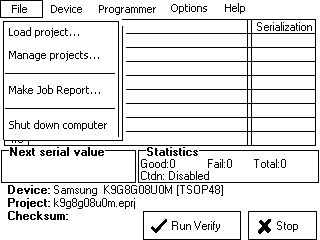 |
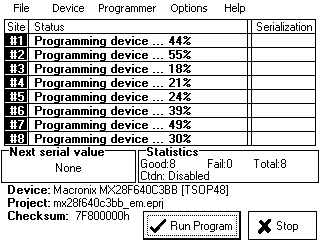 |
- Usage of a display/keyboard/mouse allows viewing all necessary information about programming flow while providing more comfort to the operator.
- Operator-friendly control software combines many powerful functions with ease of use. Graphic user interface provides an overview of all important activity results without burdening the operator with non-important details.
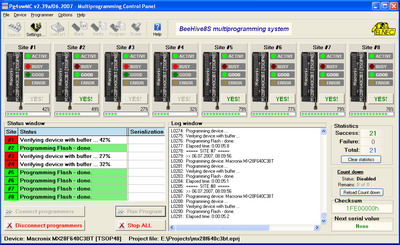 |
- A Project file is used to control the BeeHive208S Stand-Alone multiprogramming system. A Project file contains user data, chip programming setup information, chip configuration data, auto programming command sequence, etc. Operator error is therefore minimized, because the project file is normally created and proofed by engineering and then given to the operator. An optional protected mode can be set for the Project file to avoid unwanted changes to it.
- Each chip may be programmed with different data such as a unique serial number, configuration or calibration information.
SOFTWARE (programming modules driver, engineering mode control)
- This part of the software is designed for the quick and easy preparation of the project file to use in the production mode control software.
- Each programming module is driven by an easy-to-use control program with pull-down menu, hot keys and on-line help. Device selection is performed by its type, by manufacturer or simply by typing a fragment of the vendor name and/or part number. It is the same years-proven software, that is used for all other Elnec single-site programmers.
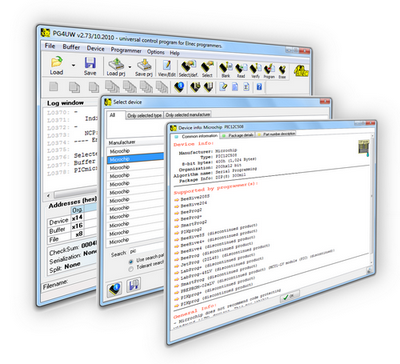
- Standard device-related commands (read, blank check, program, verify, erase) are enhanced by test functions (insertion test, connection check, signature-byte check), as well as some special functions (auto-increment, production mode – start immediately after insertion of chip into socket).
- All known data formats are supported. Automatic file format detection and conversion occurs during loading of the file. It is possible to use Jam files (JEDEC standard JESD-71) and VME files
- The rich-featured auto-increment function enables one to assign individual serial numbers to each programmed device – or simply increments a serial number. The function also enables one to read serial numbers or any programmed device identification signatures from a file.
- The software also provides considerable information about programmable devices. As a selection aide, drawings of all available packages are provided. The software provided also explains chip labelling (the meaning of prefixes and suffixes on the chips) for each supported IC.


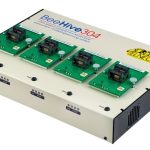
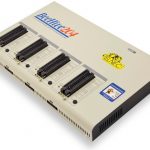





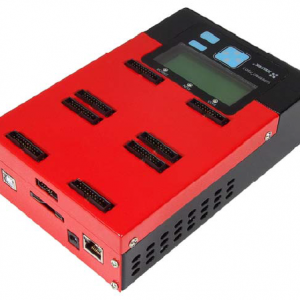
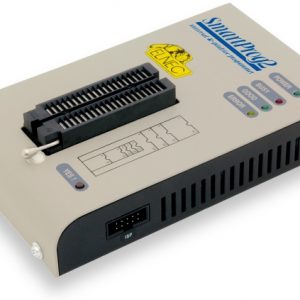

Reviews
There are no reviews yet.